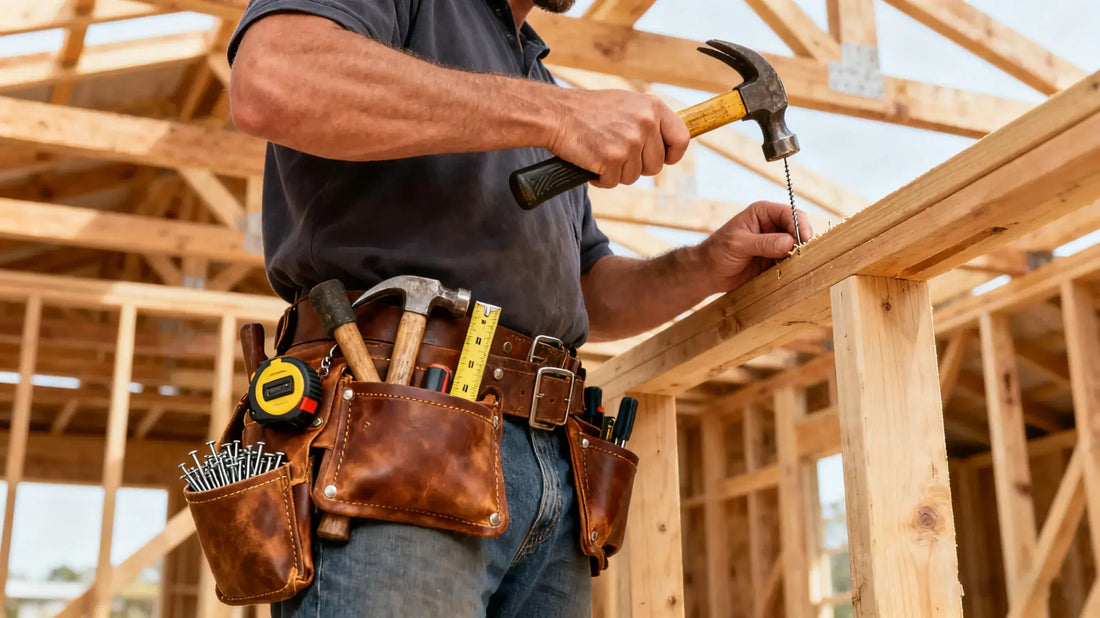
8 Shocking Carpenter Tool Belt Mistakes That Slow You Down
Share
Introduction
Every craftsman knows that efficiency on the job isn’t just about skill — it’s also about organization. One of the carpenter’s most essential accessories, the carpenter tool belt, can either make your workflow smooth or turn every project into a frustrating mess.
Yet many professionals and DIYers unknowingly make critical mistakes with their tool belts. These small missteps add wasted minutes, cause physical strain, and even risk damaging tools. In this article, we’ll uncover 8 shocking carpenter tool belt mistakes that might be slowing you down — and provide actionable solutions to fix them.
Table of Contents
1 – Wearing the Tool Belt Too Low or Too High
2 – Overloading the Tool Belt with Excess Tools
3 – Ignoring Weight Distribution
4 – Using the Wrong Pouch for the Wrong Tools
5 – Neglecting Tool Belt Maintenance
6 – Forgetting Seasonal Adjustments
7 – Using One Setup for Every Project
8 – Choosing Cheap Belts Over Quality Gear
9 – Bonus Tips for Smarter Tool Belt Use
10 – FAQs About Carpenter Tool Belts
11 – Conclusion
1 – Wearing the Tool Belt Too Low or Too High
If your carpenter tool belt sits too low, it strains your back and hips. Too high, and it limits mobility. The ideal position is just above the hips, where weight is evenly balanced.
2 – Overloading the Tool Belt with Excess Tools
A tool belt is not meant to carry your entire toolbox. Overloading leads to:
Excessive fatigue.
Difficulty finding the right tool.
Increased risk of belt tearing.
Stick to the essential tools for each project, not every tool you own.
3 – Ignoring Weight Distribution
Unbalanced belts cause discomfort and slow down work. Always balance heavy tools (like hammers) with lighter tools across both sides of the belt.
Left side: nails, screws, lighter hand tools.
Right side: hammer, tape measure, drill bits.
This small adjustment saves time and prevents muscle strain.
4 – Using the Wrong Pouch for the Wrong Tools
Pouches are designed with purpose. Using a nail pouch for screwdrivers or stuffing measuring tape into random slots causes unnecessary fumbling.
Tip: Assign each pouch a specific tool category and keep it consistent across projects.
5 – Neglecting Tool Belt Maintenance
A carpenter’s belt faces daily wear. Common issues include:
Cracked leather.
Torn nylon straps.
Rusty metal buckles.
Regular cleaning, oiling leather, and inspecting seams will keep your carpenter tool belt reliable for years.
Check out tool maintenance tips in the past: This Old House – Tool Care Tips
6 – Forgetting Seasonal Adjustments
In summer, a heavy belt can cause sweating and discomfort. In winter, thick clothing may interfere with belt positioning. Adjust your setup according to the season — sometimes switching to a lighter belt or repositioning pouches helps.
7 – Using One Setup for Every Project
No two projects are alike. A belt setup that works for roofing may not suit cabinetry. Customizing pouch arrangements for each type of job increases speed and efficiency.
8 – Choosing Cheap Belts Over Quality Gear
Bargain belts might seem appealing, but they wear out quickly and compromise comfort. A quality carpenter tool belt is an investment in durability, efficiency, and your health.
9 – Bonus Tips for Smarter Tool Belt Use
Rotate tools regularly to avoid repetitive strain injuries.
Label or color-code pouches for faster identification.
Consider suspenders for extra support during long shifts.
10 – FAQs About Carpenter Tool Belts
Q1: How many tools should a carpenter keep in a tool belt?
Stick to 8–12 essential tools depending on the project.
Q2: Are leather or nylon tool belts better?
Leather belts are durable and stylish, while nylon is lighter and more affordable. Both have advantages depending on preference.
Q3: Can tool belts cause back pain?
Yes, if worn incorrectly or overloaded. Ergonomic belts and suspenders help reduce strain.
Q4: How often should I replace my carpenter tool belt?
With proper maintenance, a high-quality belt can last 5–10 years.
Q5: Do professional carpenters still use tool belts?
Absolutely. Tool belts remain a standard in construction for efficiency and accessibility.
Conclusion
A carpenter tool belt is more than an accessory — it’s an essential partner in your craft. By avoiding these 8 shocking mistakes, you’ll save time, reduce strain, and work smarter on every project.
👉 Invest in a carpenter tool belt that works as hard as you do — because your tools deserve better than the wrong setup.
